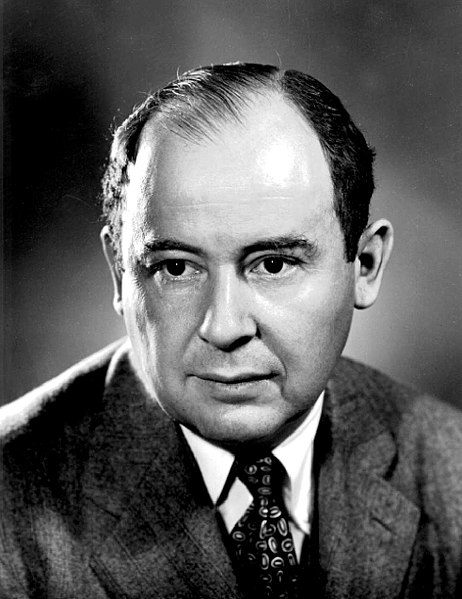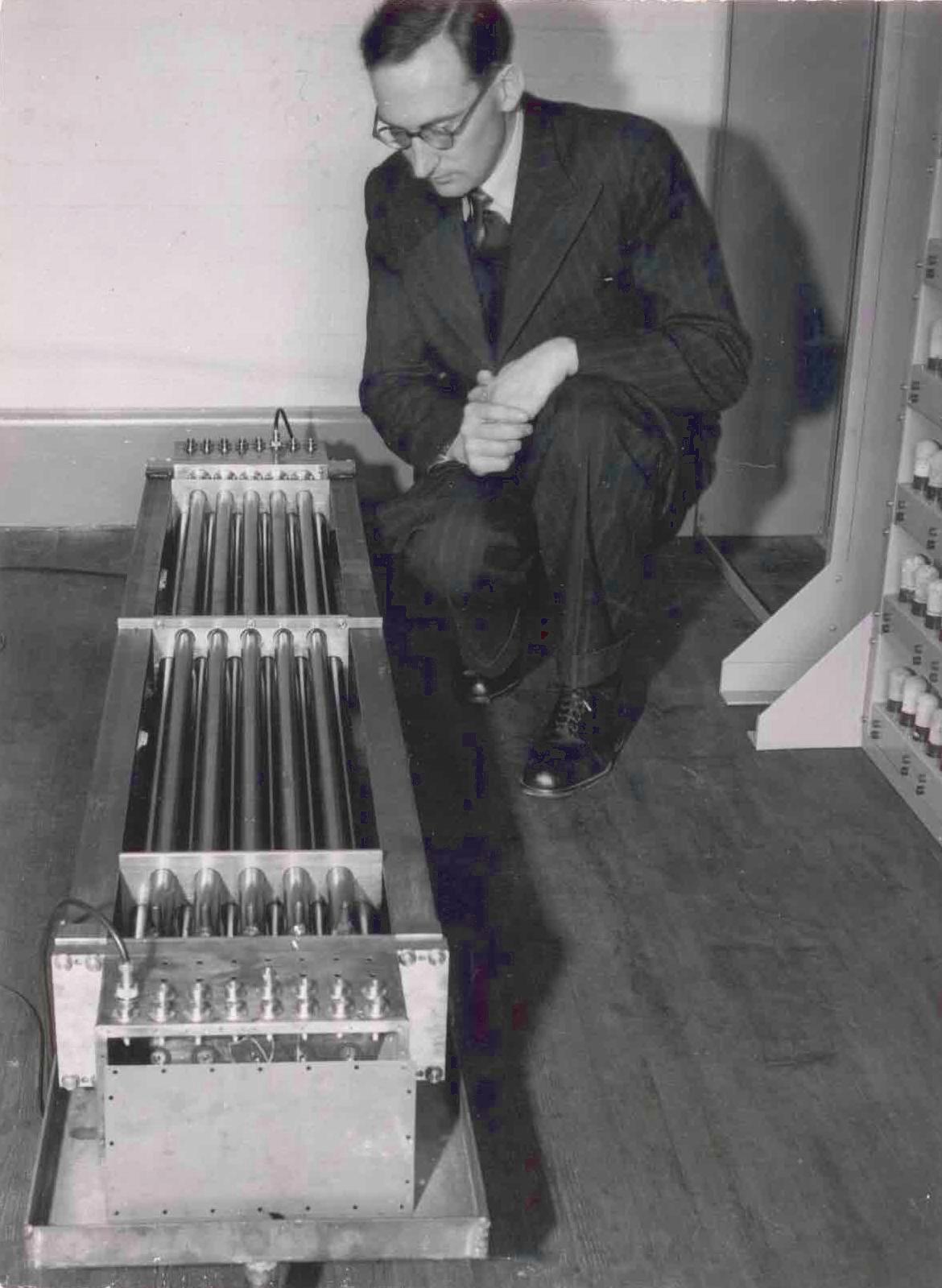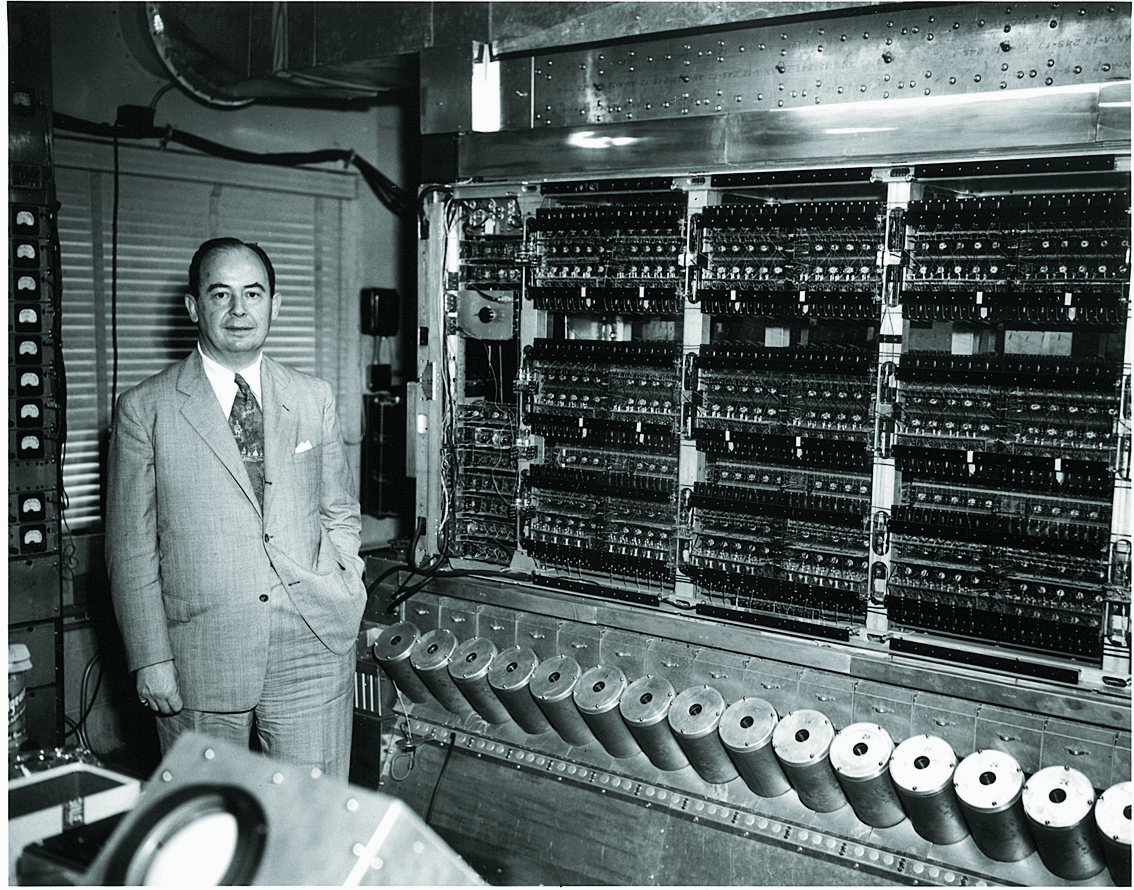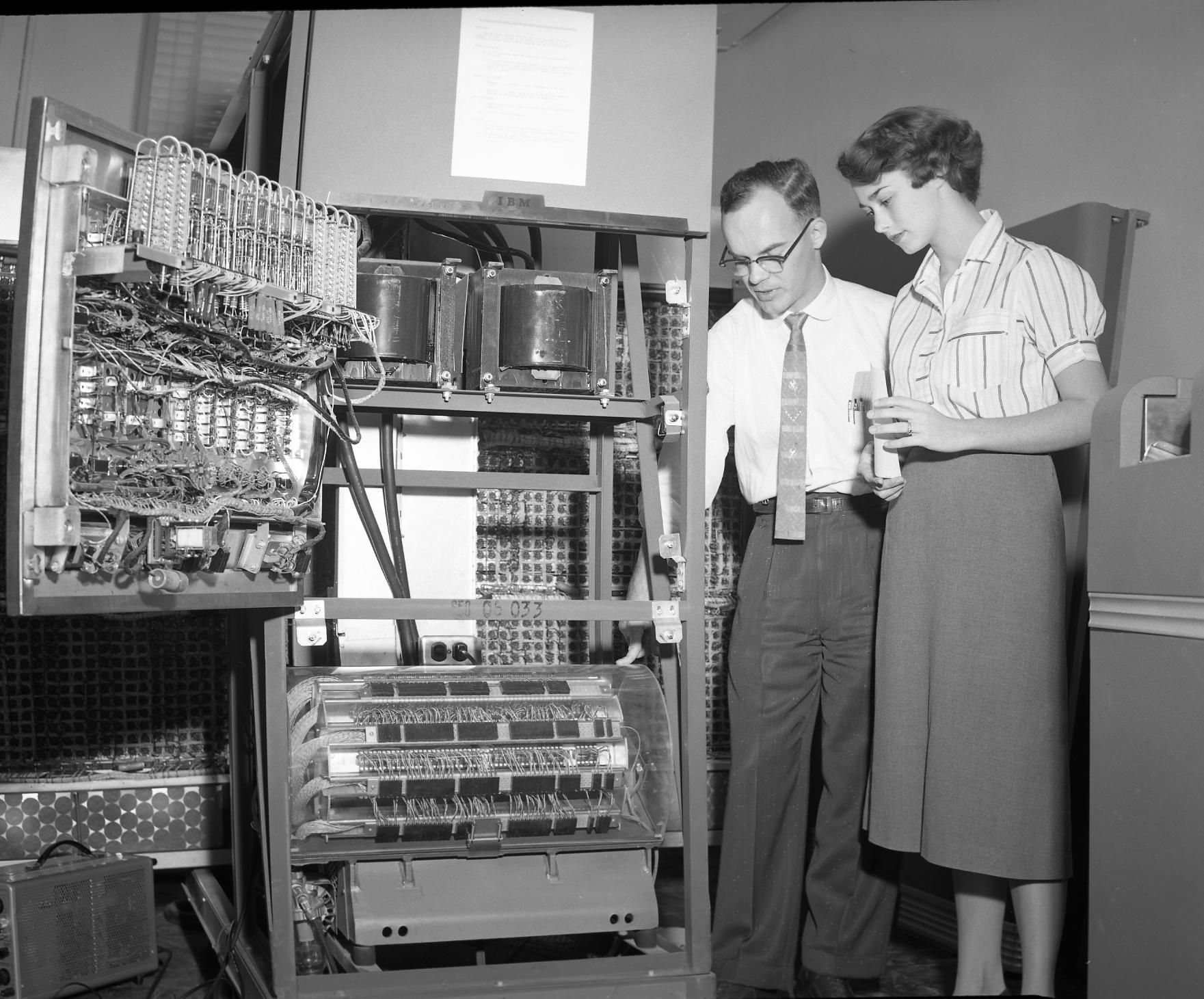The history of electronic computers, part 4: the electronic revolution

- Relay history
- The history of electronic computers
So far, we have consistently recalled each of the first three attempts to build a digital electronic computer: the Atanasoff-Berry ABC computer, conceived by John Atanasov; the British Colossus project, led by Tommy Flowers, and ENIAC, created at Moore’s School at the University of Pennsylvania. All these projects were, in fact, independent. Although John Mouchli, the main driving force behind the ENIAC project, was aware of Atanasov’s work, the ENIAC scheme was nothing like ABC. If there was a common ancestor of an electronic computing device, it was a modest Winn-Williams counter, the first device to use digital lamps for digital storage, and allowing Atanasov, Flowers and Mouchly to take the path of creating electronic computers.
But only one of these three machines, however, played a role in the events that followed. ABC never did any good work, and, by and large, those few people who knew about it forgot it. Two military vehicles proved that they are able to bypass the net speed of any other of the existing computers, but the Colossus remained secret even after the victory over Germany and Japan. Only ENIAC became widely known, and therefore became the holder of a standard for electronic computing. And now anyone who wanted to create a computing device based on electron tubes could, for confirmation, indicate the success of Moore’s school. The inveterate skepticism of the engineering community, which met all such projects before 1945, has disappeared; skeptics either changed their minds, or fell silent.
EDVAC Report
Released in 1945, a document based on the experience of creating and using ENIAC, set the tone for the development of computing technology in the world after World War II. It was called “the first draft of the EDVAC report” [Electronic Discrete Variable Automatic Computer], and provided the architecture template of the first computers that were programmed in the modern sense — that is, they executed commands that were extracted from high-speed memory. And although the exact origin of the ideas listed in it remains a matter of debate, it was signed in the name of mathematician John von Neumann (born Janos Lajos Neumann). What is characteristic of the mind of mathematics, the document also made the first attempt to abstract the scheme of the computer from the specifications of a particular machine; He tried to separate the very essence of the structure of a computer from its various probable and random incarnations.
')
Born in Hungary, Von Neumann ended up at ENIAC through Princeton (New Jersey) and Los Alamos (New Mexico). In 1929, he, as a young mathematician, with notable contributions to set theory, quantum mechanics, and game theory, left Europe in order to take up a position at Princeton University. Four years later, a nearby Advanced Research Institute (IAS) offered him a life-time job in the state. Due to the rise of Nazism in Europe, von Neumann happily jumped at the chance to remain indefinitely on the other side of the Atlantic - and became, after the fact, one of the first Jewish intellectual refugees from Hitler's Europe. After the war, he lamented: “My feelings for Europe are opposed to nostalgia, because every corner I know reminds of a world that has disappeared and ruins that do not bring comfort”, and recalled “his total disappointment in the humanity of people from 1933 to 1938”.
Averted from his youth, lost to multinational Europe, von Neumann directed all his intellect to help the military machine belonging to the country that sheltered him. For the next five years, he traveled around the country, giving advice and advising on a wide range of new weapon projects, while at the same time somehow managing to co-author a prolific book on game theory. His most secret and important job as a consultant was the position at the Manhattan project - an attempt to create an atomic bomb - whose research team was in Los Alamos (New Mexico). Robert Oppenheimer recruited him in the summer of 1943 to help with the mathematical modeling of the project, and his calculations convinced the rest of the group to move in the direction of the bomb with an explosion directed inward. Such an explosion, thanks to the explosives driving the fissile material inward, was supposed to allow a self-sustaining chain reaction to be achieved. As a result, it took a huge amount of calculations in order to achieve an ideal spherical explosion directed inwards with the necessary pressure - and any mistake would lead to the interruption of the chain reaction and the bomb fiasco.

Von Neumann while working at Los Alamos
In Los Alamos, there was a group of twenty calculators who had desk calculators at their disposal, but they could not cope with the computational load. Scientists gave them equipment from IBM to work with punch cards, but they still did not have time. They demanded improved equipment from IBM, got it in 1944, but still did not have time.
By that time, von Neumann had added another set of places to visit for his constant cruise around the country: he traveled around all the possible locations of computer equipment that could be useful at Los Alamos. He wrote a letter to Warren Weaver, head of the department of applied mathematics at the National Defense Research Committee (NDRC), and received some good leads. He went to Harvard to look at Mark I, but he was already fully loaded with work for the fleet. He talked with George Stibitz and considered ordering a Bell relay computer for Los Alamos, but abandoned the idea, finding out how long it would take. He visited a group from Columbia University, which combined several IBM computers into a larger automated system under the control of Wallace Ekert, but there were no noticeable improvements compared to those IBM computers that were already in Los Alamos.
However, Weaver did not include one project in the list that he gave to von Neumann: ENIAC. He definitely knew about him: in his capacity as director of applied mathematics, he was obliged to track the progress of all the computing projects in the country. Weaver and the NDRC could certainly have doubts about the viability and timing of the creation of ENIAC, but it is very surprising that he did not even mention its existence.
Whatever the reason for this, but as a result, von Neumann found out about ENIAC only because of a chance meeting on a railway platform. This story was told by Hermann Goldstein, the mediator of Moore’s testing laboratory at which ENIAC was built. Goldstein collided with von Neumann at the Aberdeen railway station in June 1944 - von Neumann left with one of his consultations, which he, as a member of the scientific advisory committee, gave at the Aberdeen Ballistic Research Laboratory. Goldstein knew von Neumann’s reputation as a great man, and he struck up a conversation with him. Wanting to make an impression, he could not fail to mention the new and interesting project developing in Philadelphia. Von Neumann's approach instantly changed from a complacent colleague to a tough controller, and he bombarded Goldstein with questions related to the details of the new computer. He found a new interesting source of potential computer capacity for Los Alamos.
For the first time, von Neumann visited Presper Eckert, John Mouchley and other members of the ENIAC team in September 1944. He immediately fell in love with this project and added another item to his long list of organizations for counseling. Both sides benefited from this. It is easy to see how the potential of high-speed electronic computing attracted von Neumann. ENIAC, or a similar machine, was able to overcome all the computational constraints that hindered the progress of the Manhattan project and many other existing or potential projects (however, Say’s law, which is still valid today, ensured that the appearance of computational capabilities would soon cause equal demand for them) . For Moore’s school, the blessing of such a recognized specialist as von Neumann meant the end of skepticism towards them. Moreover, given his lively mind and rich experience throughout the country, he had no equal in breadth and depth of knowledge in the field of automatic calculations.
This is how von Neumann joined the Eckert and Mouchley plan to create a follower of ENIAC. Together with Hermann Goldstein and another ENIAC mathematician, Arthur Burks, they began sketching the parameters for the second generation of electronic computers, and von Neumann summarized the ideas of this group in the report of the first draft. The new machine had to become more powerful, get smoother contours, and, most importantly, overcome the biggest barrier to using ENIAC - many hours of tuning for each new task, during which this powerful and extremely expensive computer just sat idle. The developers of the latest generation of electromechanical machines, Harvard Mark I, and Bell's relay computer avoided this by inserting instructions into the computer using a paper tape with holes punched in it — the operator could prepare the paper while the machine was solving other problems. However, such a data entry would nullify the speed advantage of the electronics; no paper could provide data as quickly as ENIAC could receive it. (“Colossus” worked with paper using photoelectric sensors and each of its five computational modules absorbed data at a speed of 5000 characters per second, but this was possible only due to the fastest possible scrolling of paper tape. Switching to an arbitrary place on the tape required a delay of 0, 5 seconds for every 5000 lines).
The solution to the problem described in the “first draft” was to transfer the storage of instructions from the “external recording medium” to the “memory” - this word was used for the first time in computer storage (von Neumann specifically used this and other biological terms in his work very interested in the work of the brain and the processes occurring in the neurons). This idea was later called "storage programs." However, this immediately led to another problem - which still confused Atanasov - the excessive cost of electronic tubes. The “first draft” estimated that a computer capable of performing a wide range of computational tasks would need a memory of 250,000 binary numbers to store instructions and temporary data. Memory on electronic tubes of this size would cost millions of dollars and would be completely unreliable.
The solution to the dilemma was proposed by Eckert, who worked in the early 1940s on radar research as part of a contract between Moore’s school and Rad Labs from MIT, the central research center for radar technologies in the United States. Specifically, Eckert worked on a radar system called the Moving Target Indicator (MTI), which solved the problem of "light from the ground": any noise on the radar screen created by buildings, hills and other fixed objects that made it difficult for the operator to isolate the important information - size, location and speed of moving aircraft.
In MTI, the problem of exposure was solved using a device called a delay line . He converted the electrical pulses of the radar into sound waves, and then sent these waves through a mercury tube so that the sound came to the other end and turned back into an electrical impulse at a time when the radar re-scanned the same point in the sky (delay lines to propagate Sound can also be used by other media: a different liquid, solid crystals, and even air. According to some sources, a physicist from Bell Labs William Shockley came up with their idea, about which later). Any signal that came from the radar at the same time as the signal on the tube, was considered a signal from a stationary object, and was removed.
Eckert understood that sound pulses in the delay line can be considered binary numbers - 1 indicates the presence of sound, 0 - its absence. A single mercury tube can contain hundreds of such figures, each of which passes through a line several times per millisecond, that is, a computer would have to wait a couple of hundred microseconds to access the figure. At the same time, access to consecutive numbers in the handset would be faster, as the numbers separated only a few microseconds.

Mercury Delay Lines in British EDSAC Computer
After solving the main problems in the computer scheme, von Neumann gathered the ideas of the whole group in a 101-page report of the “first draft” in the spring of 1945 and distributed it among the key figures of the second-generation EDVAC project. Pretty soon he got into other circles. The mathematician Leslie Comrie, for example, took a copy with him home to Britain, after a visit to Moore’s school in 1946, and shared it with his colleagues. Distribution of the report caused outrage at Eckert and Mouchly for two reasons: firstly, most of the merit in the development was attributed to the author of the draft, von Neumann. Secondly, all the main ideas contained in the system turned out to be, in fact, published from the point of view of the patent office, which hampered their plans to commercialize an electronic computer.
The very basis of resentment of Eckert and Mauchly caused, in turn, the indignation of mathematicians: von Neumann, Goldstein and Burks. From their point of view, the report was an important new knowledge that needed to be spread as widely as possible, according to the spirit of scientific progress. In addition, the entire enterprise was funded by the government, and therefore, by American taxpayers. They were repelled by the mercantile spirit of Eckert and Mouchley’s efforts to make money from the war. Von Neumann wrote: “I would never have assumed the position of a consultant at the university, knowing that I was advising a commercial group.”
The paths of the factions diverged in 1946: Ekert and Mouchli opened their own company based on a seemingly safer patent based on the ENIAC technology. At first they called their enterprise Electronic Control Company, but the following year they renamed it Eckert-Mauchly Computer Corporation. Von Neumann returned to IAS to create an EDVAC based computer, and Goldstein and Burks joined him. To prevent a repetition of the situation with Eckert and Mouchly, they made sure that all the intellectual property of the new project became public domain.

Von Neumann in front of the computer IAS, built in 1951.
Alan Turing Deviation
Among the people who saw the EDVAC report in a roundabout way was the British mathematician Alan Turing. Turing was not among the first scientists who created or invented an automatic computer, electronic or any other, and some authors greatly exaggerated its role in the history of computing technology. However, we must pay tribute to him, as the first person who guessed that computers can not just "calculate" something, tritely processing large sequences of numbers. His main idea was that the information processed by the human mind can be represented as numbers, so any mental process can be turned into a calculation.

Alan Turing in 1951
At the end of 1945, Turing published his own report, where he mentioned von Neumann, under the name "electronic calculator offer", and intended for the British State Physical Laboratory (NPL). He did not go deep into specific details of the design of the proposed electronic computer. His scheme reflected the mind of a logic specialist. It was not supposed to have special equipment for high-level functions, since they can be composed of low-level primitives; it would be an ugly growth on a beautiful symmetry machine. Also, Turing did not allocate any linear memory for a computer program — data and instructions could coexist in memory, since these were just numbers. The instruction became an instruction only when it was interpreted this way (the work of Turing 1936 “on calculated numbers” already investigated the relationship of static data and dynamic instructions. He described what was later called the “Turing machine” and showed how it can be turned into a number and feed as input to a universal Turing machine that can interpret and execute any other Turing machine). Since Turing knew that numbers could indicate any form of neatly specified information, he included in the task list for solving on this calculator not only the construction of artillery tables and the solution of systems of linear equations, but also the solution of puzzles and chess sketches.
The automatic Turing computer (ACE) has never been created in its original form. He was too slow, and he had to compete with more zealous British computing projects for better talents. The project skidded for several years, and then Turing lost interest in him. In the 1950s, the NPL made the Pilot ACE - a smaller machine and a slightly different design, and in the early 1950s several other computer projects took inspiration from the ACE architecture. But she failed to expand her influence, and she quickly went into oblivion.
But all this does not diminish the merits of Turing, it just helps put it in the right context. The importance of its influence on the history of computers is not based on the designs of computers of the 1950s, but on the theoretical basis that he prepared for computer science, which appeared in the 1960s. His early work on mathematical logic, which studied the limits of computable and noncomputable, became the fundamental texts of the new discipline.
Leisurely revolution
With the spread of news about ENIAC and EDVAC report, Moore’s school became a place of pilgrimage. Many visitors came to learn "at the feet of the masters," especially from the United States and Britain. To streamline the flow of applicants, the dean of the school in 1946 had to organize a summer school on automatic computers, working by invitations. Lectures were given to such luminaries as Ekert, Mouchli, von Neumann, Burks, Goldstein and Howard Aiken (developer of the Harvard electromechanical computer Mark I).
Now almost everyone wanted to create machines according to the instructions from the EDVAC report (ironically, ENIAC itself was the first machine that started the program stored in memory, which was converted in 1948 to use the instructions stored in memory. Only after that it began to work successfully in its home, Aberdeen Proving Ground). Even in the names of new computer projects created in the 1940s and 50s, the influence of ENIAC and EDVAC was traced. Even if you do not take into account UNIVAC and BINAC (created by the new company Eckert and Mouchly) and EDVAC itself (finished at Moore’s school after its founders left it), AVIDAC, CSIRAC, EDSAC, FLAC, ILLIAC, JOHNNIAC, ORDVAC still remain , SEAC, SILLIAC, SWAC and WEIZAC. IAS ( ), .
, . EDVAC 1948-, , , «», ( , . -. , , ). 1949 : Manchester Mark I, EDSAC , CSIRAC () BINAC – . , .
ENIAC , . - . « ENIAC Mark I ( )» – [Katherine Davis Fishman, The Computer Establishment (1982)]. , , , . , , . , Mark I , : « Mark I , . , , » [Aspray and Campbell-Kelly]. - .
, . , 1950- . , , ( , ). ENIAC 150 , 20 .
«» . 1940- , – . , ENIAC, IBM, . 1949 : ENIAC ; V , IBM , . , , ( ) .
1945 , ENIAC, 1954-, IBM 650 704. , , , IBM , . , 1940-, , ; .

IBM 650 – A&M. () , .
1950- , . 1930- 40- , . , , .
, . . . . , , , , «».
, , , . , , . 1948 , «, 10 000 (, , ), )». , ; , , , ; , . , , .
:
- David Anderson, “Was the Manchester Baby conceived at Bletchley Park?”, British Computer Society (June 4th, 2004)
- William Aspray, John von Neumann and the Origins of Modern Computing (1990)
- Martin Campbell-Kelly and William Aspray, Computer: A History of the Information Machine (1996)
- Thomas Haigh, et. al., Eniac in Action (2016)
- John von Neumann, “First Draft of a Report on EDVAC” (1945)
- Alan Turing, “Proposed Electronic Calculator” (1945)
Source: https://habr.com/ru/post/447916/
All Articles